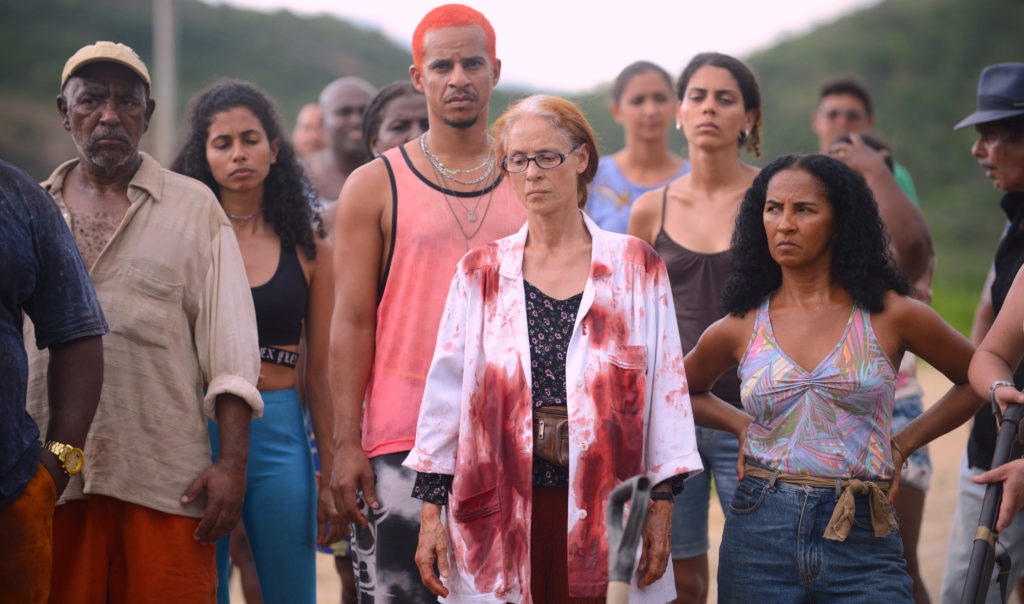Interview with Richard Lorber, Chief Executive Officer, Kino Lorber
Kino Lorber’s theatrical release of festival hit Bacurau, which garnered critical praise at major events like Cannes and NYFF, began its run in New York City on March 6. An expansion to arthouse theaters nationwide was scheduled for the ensuing weeks, but was ultimately cut short as COVID-19 began its spread across the country. With its theatrical commitments cut short by the virus, the distributor quickly came together to discuss next steps to salvage the film’s release. Rather than opting for a traditional home entertainment launch, the way bigger studios like Paramount and Universal have, Kino Lorber decided to create a program that would share revenues of digital rentals of the film with the arthouse cinemas affected by the crisis.
The program, Kino Marquee, was rolled out days after cinemas announced they would be suspending operations due to the coronavirus. Starting with 11 cinemas, the virtual theatrical program now counts more than 150 participating movie theaters. Boxoffice Pro spoke with Kino Lorber CEO Richard Lorber to get the behind-the-scenes story of how the distributor quickly mobilized to launch the concept.
How did your virtual theatrical concept come about?
We obviously were not anticipating this, but were covertly prepared for it because we had built out our own VOD platform last year, [Kino Now]. [It] was a TVOD platform, Transactional VOD (TVOD), not Subscription VOD (SVOD) .
We didn’t want to join the fray of all the small companies starting SVODs, competing with giants like Disney and Netflix. We are about selling movie tickets in theaters and feel that a transactional VOD platform is a fit. We didn’t really think about crossing that over to theatrical, because we typically respect the the traditional theatrical [window].
Like many other distributors, this crisis hit as you were just launching a high-profile release, the Brazilian genre favorite Bacurau. Rather than simply forgoing the theatrical commitment and dropping the film on regular streaming services, Kino Lorber mobilized its team to launch Kino Marquee’s virtual theatrical concept in a matter of days. How did your team come to that decision?
Suddenly, this circumstance arose where we found that the 60 or 80 theaters that had booked Bacurau, one of our top titles of the year, coming in very well-reviewed from after winning the jury prize in Cannes and playing in the New York Film Festival and Toronto. All of a sudden, our theatrical release is cut short barely after it began, coming into it with great momentum and a Critic’s Pick in the New York Times.
The biggest concern was that all the theaters that we were dealing with suddenly shut their doors. We are very supportive of the independent arthouse theaters that that support what we do and thrive on what we do. We occasionally deal with chains, but they aren’t traditionally our bread and butter. Indie arthouse theaters are crucial to our business model. We tried to come up with a solution that could both rescue our particular release during this time and also create a revenue stream for the lost income for our partner theaters.

These are theaters that were very eager to book Bacurau and had already spent funding sources to promote the film and engage their membership base. We came to the conclusion that we could, in effect, hybridize our theatrical distribution model with our VOD technology, and that’s how we came up with Kino Marquee, which is intended to represent first run theatrical films and repertory titles available to theaters as a virtual screening opportunity and an extension of what they would be doing in physical theaters. The plan was to make this platform totally theater-centric, where we respect all of the parameters of the traditional theatrical model, including clearances [and] regional or neighborhood exclusivity. We respect the two traditional digital holdbacks from VOD and created a model where they could have a digital version of the film to show to their customers and members that would not be available on any other VOD platform.
We got pretty excited about this. Literally, in a period of 72 hours from dreaming up the concept and name, our fantastic team at Kino Lorber all jumped on this.
What is the potential of Kino Marquee beyond the COVID-19 crisis?
We chose to do this in a way that did not push forward our own branding as Kino Lorber or Kino Now. We’re not using this as a Trojan horse to infiltrate their membership base and divert actual theatergoers to watching VOD and digital copies. This is intended as an interim provision to cover this crisis period. That’s with the hope that in some weeks, probably months, theaters will reopen, and people will go back to smelling the popcorn and hopefully buying it. We would have fulfilled a service in the stop-gap. We also realize that even when that happens, and we hope it will happen as soon as possible…this Kino Marquee model is something that can still be productive for theaters as an extension of their own screening capabilities.
One of the things that we all know in this world of too many films passing through the system is that even great films that are well reviewed and that audiences love will often find themselves locked in a week or two-week run, and then they’re gone. And the the theaters can’t do anything about it when they only have two or three screens. This gives them virtually infinite additional screens where they can add holdovers and repertory to create a new model for supplemental income, even as they resume their normal physical theatrical operations.
How many theaters are currently participating in the Kino Marquee virtual theatrical program?
We went from 11 theaters to now well over 100, including most recently Alamo Drafthouse. There will probably be upwards of 200 theaters participating on Bacurau and one or two other films that are coming behind it. We also just launched Ken Loach’s award-winning film from Cannes, Sorry We Missed You, which premiered at Film Forum–and now Film Forum has come aboard to extend their run a virtual screening.
This is working, and it’s very exciting to us. The scale of the revenues isn’t quite replacing what the physical revenues would have been, but it may in time. We’re really doing it basically to enable the theaters to stay in business with some revenue stream and maintain their visibility and their value to their customers, supporters, and members.
The virtual theaters that are booking it are in some cases theaters that, for one reason or another, we don’t usually get to play in. They’re either looking for the bigger studio indies that have massive P&A budgets or they’re looking for slightly more commercial films.
There are opportunities for us to create this virtual screening platform for entities that are not actually movie theaters, like film societies or cultural groups that may have a sporadic film screening here or there. This can enable them to actually create a virtual theater, irrespective of whether they have a physical screening capability or not. Right now, the current model is basically one film to many screens. We’re now working on a multiplexing model where we can have many or several films available to one organization. That would also be a model for our repertory offerings. All in all, this is a an opportunity to not only work with movie theaters and film festivals, but also with organizations that have a customer base that is also interested in seeing cinema.

Are you planning on adding more titles to Kino Marquee in the coming weeks?
Many of our colleagues, other distributors, who are competitors but also colleagues, have asked if they can access our platform. We’re selectively opening our doors to certain other films from other distributors. Right now, it’s not an open source platform. It’s not a white label solution that we’re licensing to other companies. We really feel the two key critical components to make this successful are the caliber of film. First and foremost, is it a film that we’re really proud to distribute and we think our arthouse independent theaters really want? And two, will those theaters be able to promote it and activate their base? Will they be able to message the opportunity to screen something digitally under the auspices of their theater and and capture the commitment of their customers?
Whether those are films just from our own current release schedule or supplemented by the films from other distributors remains to be seen. We initially started with films that already had theatrical booking commitments. It was already a situation where the theaters had said, “We want this film physically in our theater.” That was the first step, and it was relatively easy to convert most of those theaters to take the virtual screening opportunity. What we immediately found happening was that on Bacurau, the number of theaters that had not committed, that never said they wanted to book it physically, have now come to us to take it virtually. The number of bookings for Bacurau was at least double what we had from the physical side.
How can movie theaters sign up to be part of Kino Marquee?
Theaters just have to do two things: send us their logo to incorporate onto our virtual marquee, and provide a few sentences [about their organization]…. It’s as simple as that. We do everything else. The most important thing they do after that initial setup is to message and activate their customer base to do this. Some [theaters] have weekly or frequent newsletters…. They have special communication protocols with their members, customers, and a wider audience. It’s crucial they do that, because this is still new to their customers and members. It has to be done with some repeated reinforcement to remind them. The [theaters] that have been most successful, they’re the ones that have been relatively persistent in this. We help theaters with some best practices suggestions, but most theaters we deal with are pretty good at activating their base. And that’s their competitive advantage, frankly, compared to the chains. Indie art-houses are really in touch and of the cloth of their communities. That’s really the key to making this work. It gives them a survival advantage in this time of great pain for everyone.
How can moviegoers support their local cinema through Kino Marquee?
We’re trying to encourage individual moviegoers to connect with the page from their local movie theater. The simplest way to find that out is by going to the Kino Lorber website, look for the title they want to see, and see playlist guide that lists all of the theaters that are showing. They then click on the theater page for their local theater and buy a ticket. It’s $12, and approximately half of that goes back to the theater. It’s available for multiple viewing. You can watch it as many times as you want over a five day period. [You can] stop and start it again.
This model is not going to put Netflix out of business, but it is nice to enable and facilitate the theater to use digital to secure the future of their [business]. We look forward to the day where this will just be an expansion of what theaters can do to keep their business healthier than ever.



Share this post